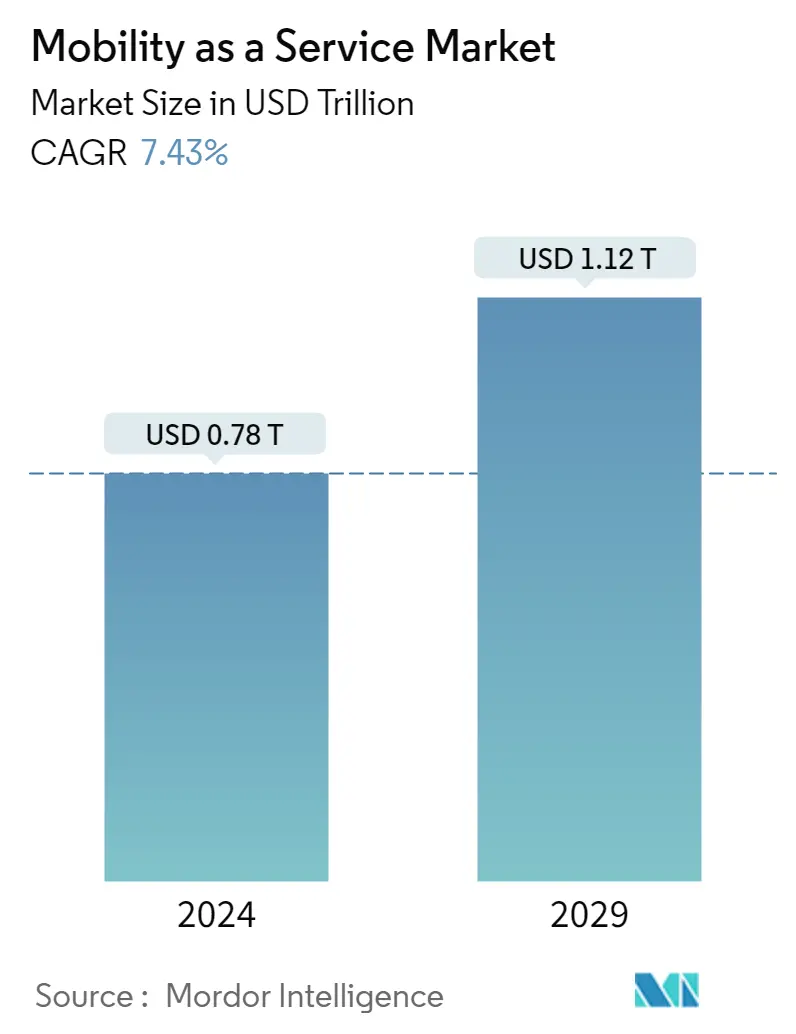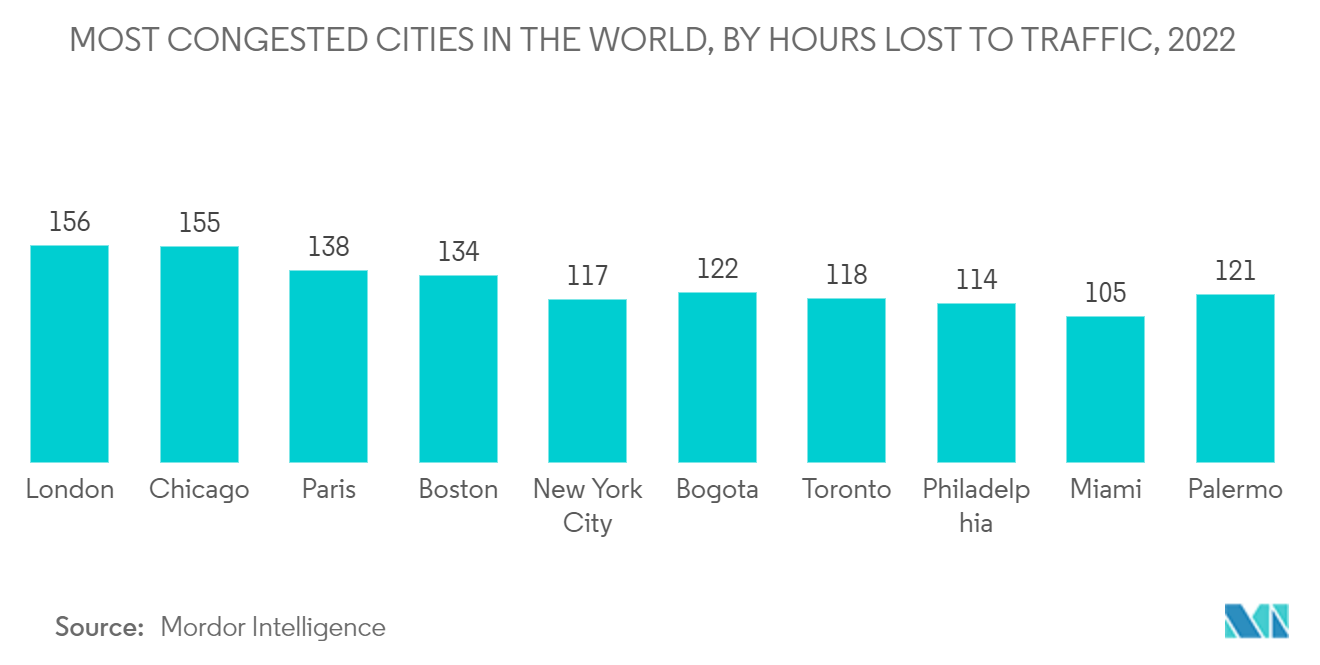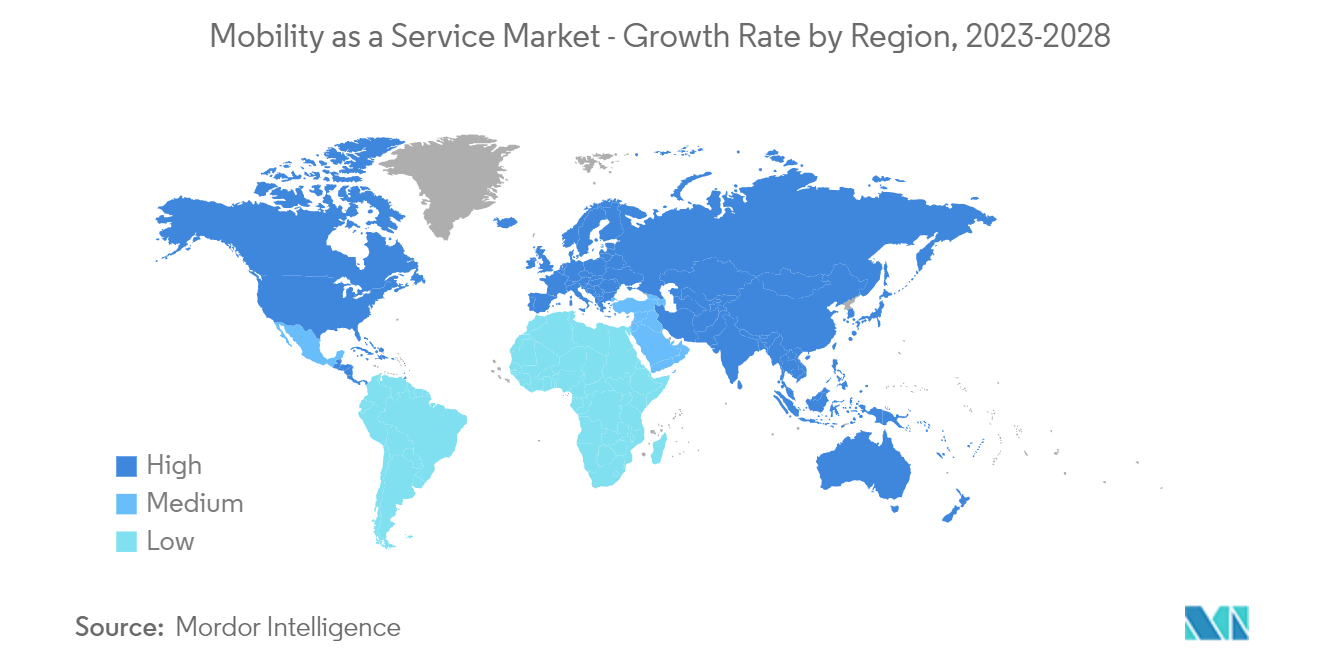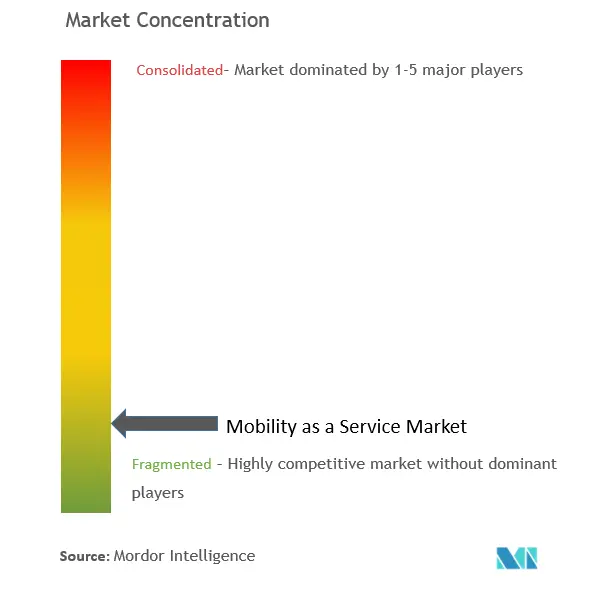Mobility as a Service (MaaS) Market Size

| Study Period | 2019 - 2029 |
| Market Size (2024) | USD 0.78 Trillion |
| Market Size (2029) | USD 1.12 Trillion |
| CAGR (2024 - 2029) | 7.43 % |
| Fastest Growing Market | Asia-Pacific |
| Largest Market | North America |
Major Players
*Disclaimer: Major Players sorted in no particular order |
Mobility as a Service (MaaS) Market Analysis
The Mobility as a Service Market size is estimated at USD 0.78 trillion in 2024, and is expected to reach USD 1.12 trillion by 2029, growing at a CAGR of 7.43% during the forecast period (2024-2029).
The COVID-19 pandemic hurt mobility as a Service Market. With the lockdown and social distancing norms implemented worldwide, the need for mobility was reduced except for emergency purposes. With almost zero public movements, the major business area of the market was severely hit, and the economy took a nosedive. Although the COVID-19 pandemic has caused problems for the market, it has also given rise to chances for innovation and adaptation, such as the deployment of MaaS solutions for contactless payments and contact tracking.
Over the medium term, Mobility as a Service (MaaS) is a growing industry that intends to provide individuals and businesses with integrated, on-demand transportation solutions. It represents a paradigm shift from traditional modes of transportation, in which consumers can access a variety of mobility alternatives through a single platform, frequently via a subscription-based approach. The market is predicted to expand rapidly in the next years, owing to rising urbanization, increased traffic congestion, and a need for more sustainable transportation alternatives.
Passengers' preferences for utilizing taxi services and ride-sharing services across the country are expected to increase. Hence, this is likely to lead the companies to enhance the options and expand their operations to be provided in mobile applications, to retain their respective market shares in a highly competitive market.
The growing emphasis on lowering carbon emissions and mitigating climate change is one of the primary drivers of the MaaS sector. MaaS platforms may help lessen the environmental effect of transportation by providing more sustainable mobility options.
Another important aspect driving the market is changing consumer tastes, particularly among younger generations that prioritize convenience, flexibility, and cost-effectiveness in their mobility options.
Other players, such as automakers and public transportation agencies, are entering the MaaS sector to stay competitive and meet evolving customer expectations, in addition to traditional transportation corporations and tech startups.
Government initiatives and legislation, such as subsidies for electric vehicles and encouragement for carpooling and public transit use, are also shaping the MaaS market. Mobile apps, Internet of Things (IoT) gadgets, and data analytics tools are a few of the primary technologies powering the MaaS sector. These technologies enable more effective and individualized transportation services.
Mobility as a Service (MaaS) Market Trends
Increasing Traffic Congestion Drive the Demand in the Market
MaaS can assist in improving air quality, lower carbon emissions, and encouraging sustainable transportation in addition to easing congestion. MaaS can encourage individuals to select more environmentally friendly forms of transportation, like biking or taking public transportation, by providing a variety of mobility options.
In addition, MaaS is reshaping the transportation sector by giving actors in the public and commercial sectors new business models and opportunities. While governments look for ways to incorporate MaaS into their transportation networks, private companies are increasing their investments in MaaS platforms and services.
Overall, the difficulties caused by traffic congestion in major cities throughout the world are a contributing factor in the expansion of the MaaS sector. MaaS is positioned to play an increasingly significant role in the future of urban mobility as people look for more effective and environmentally friendly transportation solutions.
In recent years, many cities around the world have been adopting mobility as a service (MaaS) as a solution to the growing traffic congestion and transportation challenges. For instance,
- In January 2023, The Mobility Department of the City of Tampa launched a Mobility as a Service (MaaS) trial project with the City's new mobility partner, Moovit. Moovit debuted in Tampa as an urban mobility software that assists users in planning multimodal trips, whether they want to walk, bike, scoot, drive, ride the streetcar, or take the bus. In addition to delivering precise and reliable urban mobility information, Moovit offers mobile ticketing for public transportation, real-time arrival information, and displays parking lots and park-and-ride locations, unlike Google Maps or Waze.
- In October 2022, Shanghai inaugurated an all-in-one mobile platform for green commuting, marking an important step forward in the development of the city's Mobility as a Service (MaaS) system. The Suishenxing app, the world's first metropolitan MaaS platform established by a government, has completed its fundamental features, which include public transportation, taxi hailing, and smart parking. Users can get a swipe-for-all pass that contains all public transportation codes through its public transportation service. After registering and activating the payment feature on MaaS, it can now be used on Shanghai's 1,560 bus routes, 17 ferry lines, and 11 Metro lines.
- In September 2022, the City of Prague tested a pilot program to consolidate all payment methods and transit services in one location. A system for unified registration and payment for mobility services, such as bike and carsharing, taxis, parking, and public transportation, will be developed, tested, and operated via the Ltaka app, which is being implemented by Prague's municipal firm Operátor ICT.
These instances show how MaaS is becoming more and more popular among cities as they work to ease traffic congestion and increase accessibility to transportation. It is anticipated that more cities using MaaS solutions to solve their transportation problems as the MaaS business expands globally.

Asia-Pacific is the Fastest Growing Market
Urbanization, population growth, and increasing demand for convenient and sustainable modes of transportation are likely to enable the mobility-as-a-service market in China over the long run. In recent years, new mobility represented by emerging bike-sharing and car-hailing/sharing has provided great convenience for citizens' daily transport. By meeting large mobility demands, they also brought pressures and challenges to city management. In addition, they had a big impact on existing public transport systems and traditional transport services.
China has focused on testing and developing MaaS projects in recent years. Many government departments, such as the State Council, Ministry of Transport, and province and city governments (Beijing, Shanghai, Jiangsu, and Guangdong), have highlighted to develop of a MaaS strategy or pilot in their 14th-Five-Year Plan between (2021-2025) or even in their long-term plan for 2035.
India is the second-most populous country in the world, and most people fall into the middle-class category who utilize cabs and auto-rickshaws (local three-wheeler taxis) for commuting short distances. India's public transportation system is not that well developed and is mainly characterized by buses, local trains (only in Mumbai), and metros (in select cities). Thus, employees majorly use their personal vehicle as the main mode of transportation to work.
MaaS is still relatively new in India, but discussions and policy initiatives by the federal, state, and local governments have highlighted its enormous potential. MaaS would offer consumers across India the ability to effortlessly organize trips in a flexible and personalized way by integrating transportation into a single service. Further, India is utilizing its technology prowess and integrated mobility services solutions, and it is already growing into a sizable sector.
Due to the outpouring opportunities in the Indian market, many prominent companies have also taken severe initiatives to strengthen their position in the Maas market. For instance,
- In January 2023, ride-hailing company Uber plans to introduce 25,000 electric cars in India over the next three years through its platform. A memorandum of understanding signed with Tata Motors envisages the phased delivery of 25,000 units of Tata's Xpres-T EV electric car from this month. Electric vehicles will be deployed in Delhi, Mumbai, Kolkata, Chennai, Hyderabad, Bengaluru, and Ahmedabad.
- In November 2022, an all-in-one mobile platform for green commuting in Shanghai was launched, marking an essential step forward for Shanghai's Mobility as a Service (MaaS) system.
- In October 2021, Honda launched Ashirase, a wearable device that helps visually impaired individuals navigate their surroundings using vibrations and audio guidance. The device is part of Honda's efforts to expand mobility services beyond traditional vehicles.
The above developments indicate that the MaaS market in the region is growing rapidly, with several players entering the market and expanding their services. These developments are expected to contribute to MaaS growth in the coming years.

Mobility as a Service (MaaS) Industry Overview
The mobility as a service market is fragmented, with several players accounting for significant shares in the market. Some prominent companies in the mobility as a service market are Uber, Didi, Beeline Mobility, Moovit, and others. Companies are investing heavily in R&D for the innovation of new and advanced products.
- In December 2022, SafeUP, the new startup behind the only community safety app that allows women and girls to crowdsource their safety and protect one another in real time, announced a collaboration with Moovit. SafeUP members will be able to easily plan their journeys and navigate public transportation thanks to this alliance in honor of International Day for the Elimination of Violence Against Women.
- In August 2022, Lime, an electric vehicle company, and Whim, a mobility app, expanded their collaboration to another country. In June 2022, Whim launched e-scooters in Antwerp and Brussels, Belgium, followed by Helsinki, Finland. Whim has access to all Lime e-scooters in Zurich, Winterthur, and Basel. Whim, in addition to two other e-scooter providers in more than ten cities, allows users to plan, book, and pay for trips using multiple modes of transportation.
- In May 2022, FOD Mobility Group introduces customized marketing support services for Mobilleo customers. FOD Mobility Group now offers a comprehensive range of tailored marketing support services for clients who may not have the necessary marketing experience or resources in-house, in addition to providing the Mobility as a Service (MaaS) technology itself via their market-leading Mobile platform. Market research, strategy and planning, app store setup and management, online/offline advertising, PR, event management, email campaigns, social media management, content creation, graphic design, website design, SEO, and engagement with local businesses and tourist boards are just a few of the services offered.
Mobility as a Service (MaaS) Market Leaders
-
Uber Technologies Inc.
-
Didi Chuxing
-
The Hertz Corporation.
-
Avis Budget Group
-
Enterprise Holdings, Inc.
*Disclaimer: Major Players sorted in no particular order

Mobility as a Service (MaaS) Market News
- In February 2023, Uber partnered with financial services firm HSBC to launch a digital payments solution that allows unbanked drivers in Egypt to receive on-demand cash outs into mobile wallets. Through this collaboration, the companies hope to provide Uber platform drivers with access to 100% of their earnings in a timely and convenient manner via HSBC Net's payment solution.
- In January 2023, DiDi begins working with Jordan Transfer Guidance. Begin taxi dispatch on routes that include the last mile in the transfer guidance app in collaboration with the transfer guidance app. This collaboration is part of Jordan's MaaS service and tourism DX business, and it is an initiative that anticipates the return of tourists from other countries, including China.
- In December 2022, Moovit, a new urban mobility app that launched in Tampa, assists users in planning multimodal trips, whether they prefer to walk, bike, scoot, drive, ride the streetcar, or take the bus. The Mobility as a Service (MaaS) Pilot begins with the local launch of Moovit, which includes multimodal trip planning and integration with HART mobile ticketing. By expanding on its world-renowned transit app, the city has pressed Moovit to address gaps in transit access and improve connectivity between modes of transportation.
Mobility as a Service (MaaS) Market Report - Table of Contents
1. INTRODUCTION
- 1.1 Study Assumptions
- 1.2 Scope of the Study
2. RESEARCH METHODOLOGY
3. EXECUTIVE SUMMARY
4. MARKET DYNAMICS
- 4.1 Market Drivers
- 4.2 Market Restraints
-
4.3 Industry Attractiveness - Porter's Five Forces Analysis
- 4.3.1 Bargaining Power of Buyers/Consumers
- 4.3.2 Bargaining Power of Suppliers
- 4.3.3 Threat of New Entrants
- 4.3.4 Threat of Substitute Products
- 4.3.5 Intensity of Competitive Rivalry
5. MARKET SEGMENTATION (Market Size in Value - (USD Billion)
-
5.1 By Service Type
- 5.1.1 Car
- 5.1.2 Bus
- 5.1.3 Bike
-
5.2 By Transportation Type
- 5.2.1 Public
- 5.2.2 Private
-
5.3 By Geography
- 5.3.1 North America
- 5.3.1.1 United States
- 5.3.1.2 Canada
- 5.3.1.3 Rest of North America
- 5.3.2 Europe
- 5.3.2.1 Germany
- 5.3.2.2 United Kingdom
- 5.3.2.3 France
- 5.3.2.4 Rest of Europe
- 5.3.3 Asia-Pacific
- 5.3.3.1 India
- 5.3.3.2 China
- 5.3.3.3 Japan
- 5.3.3.4 South Korea
- 5.3.3.5 Rest of Asia-Pacific
- 5.3.4 Rest of the World
- 5.3.4.1 South America
- 5.3.4.2 Middle-East and Africa
6. COMPETITIVE LANDSCAPE
- 6.1 Vendor Market Share
-
6.2 Company Profiles*
- 6.2.1 Whim (Maas Global)
- 6.2.2 Uber Technologies Inc.
- 6.2.3 Didi Chuxing
- 6.2.4 Citymapper
- 6.2.5 Moovel
- 6.2.6 Beeline Mobility
- 6.2.7 Ubigo (via-id)
- 6.2.8 Moovit Inc.
- 6.2.9 Bridj Technology Pty Ltd.
- 6.2.10 Mobileo
- 6.2.11 The Hertz Corporation
- 6.2.12 Avis Budget Group
- 6.2.13 Enterprise Holdings Inc.
7. MARKET OPPORTUNITIES AND FUTURE TRENDS
** Subject To AvailablityMobility as a Service (MaaS) Industry Segmentation
Mobility as a service integrates various forms of transportation services. It allows a variety of transportation services access, including public transport, ride-share, and rental.
The Mobility as a Service Market is Segmented by Service Type (Car, Bus, and Bike), Transportation Type (Public and Private), and Geography (North America, Europe, Asia-Pacific, and the Rest of the World). The report offers market size and forecasts for Mobility as a Service in terms of value (USD billion) for all the above segments.
| By Service Type | Car | |
| Bus | ||
| Bike | ||
| By Transportation Type | Public | |
| Private | ||
| By Geography | North America | United States |
| Canada | ||
| Rest of North America | ||
| By Geography | Europe | Germany |
| United Kingdom | ||
| France | ||
| Rest of Europe | ||
| By Geography | Asia-Pacific | India |
| China | ||
| Japan | ||
| South Korea | ||
| Rest of Asia-Pacific | ||
| By Geography | Rest of the World | South America |
| Middle-East and Africa |
Mobility as a Service (MaaS) Market Research FAQs
How big is the Mobility as a Service Market?
The Mobility as a Service Market size is expected to reach USD 0.78 trillion in 2024 and grow at a CAGR of 7.43% to reach USD 1.12 trillion by 2029.
What is the current Mobility as a Service Market size?
In 2024, the Mobility as a Service Market size is expected to reach USD 0.78 trillion.
Who are the key players in Mobility as a Service Market?
Uber Technologies Inc. , Didi Chuxing , The Hertz Corporation. , Avis Budget Group and Enterprise Holdings, Inc. are the major companies operating in the Mobility as a Service Market.
Which is the fastest growing region in Mobility as a Service Market?
Asia-Pacific is estimated to grow at the highest CAGR over the forecast period (2024-2029).
Which region has the biggest share in Mobility as a Service Market?
In 2024, the North America accounts for the largest market share in Mobility as a Service Market.
What years does this Mobility as a Service Market cover, and what was the market size in 2023?
In 2023, the Mobility as a Service Market size was estimated at USD 0.73 trillion. The report covers the Mobility as a Service Market historical market size for years: 2019, 2020, 2021, 2022 and 2023. The report also forecasts the Mobility as a Service Market size for years: 2024, 2025, 2026, 2027, 2028 and 2029.
What are the key cybersecurity considerations for companies operating in the (MaaS) Mobility-as-a-Service Market?
The key cybersecurity considerations for companies operating in the (MaaS) Mobility-as-a-Service Market are a) Data privacy concerns b) Security service edge (SSE) security c) Protecting sensitive information within the MaaS ecosystem
Mobility as a Service Industry Report
The mobility-as-a-service market (MaaS) is on a significant upswing, fueled by the demand for sustainable, efficient transportation amidst rapid urbanization and growing traffic woes. This burgeoning market merges various transport modes into one platform, offering flexible, tailored travel solutions. Key to its growth are the rise in smartphone use and advancements in 4G/5G networks, making MaaS apps more accessible for navigating, booking, and payments. Despite challenges like integrating diverse payment systems and scaling infrastructure, the sector sees opportunities in expanding services like on-demand ferries and freight. The Asia-Pacific region, in particular, shows promise due to its vast population and urbanization pace. The competitive landscape is lively, with companies innovating to cater to commuter needs, indicating a bright future for MaaS. For detailed insights, Mordor Intelligence™ provides comprehensive analysis, including market share, size, revenue growth, and forecasts in a free report PDF download, highlighting the mobility as a service market's dynamic growth and potential.



